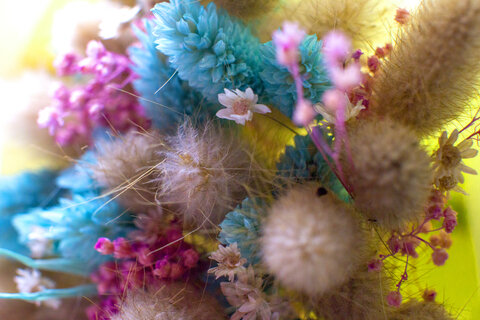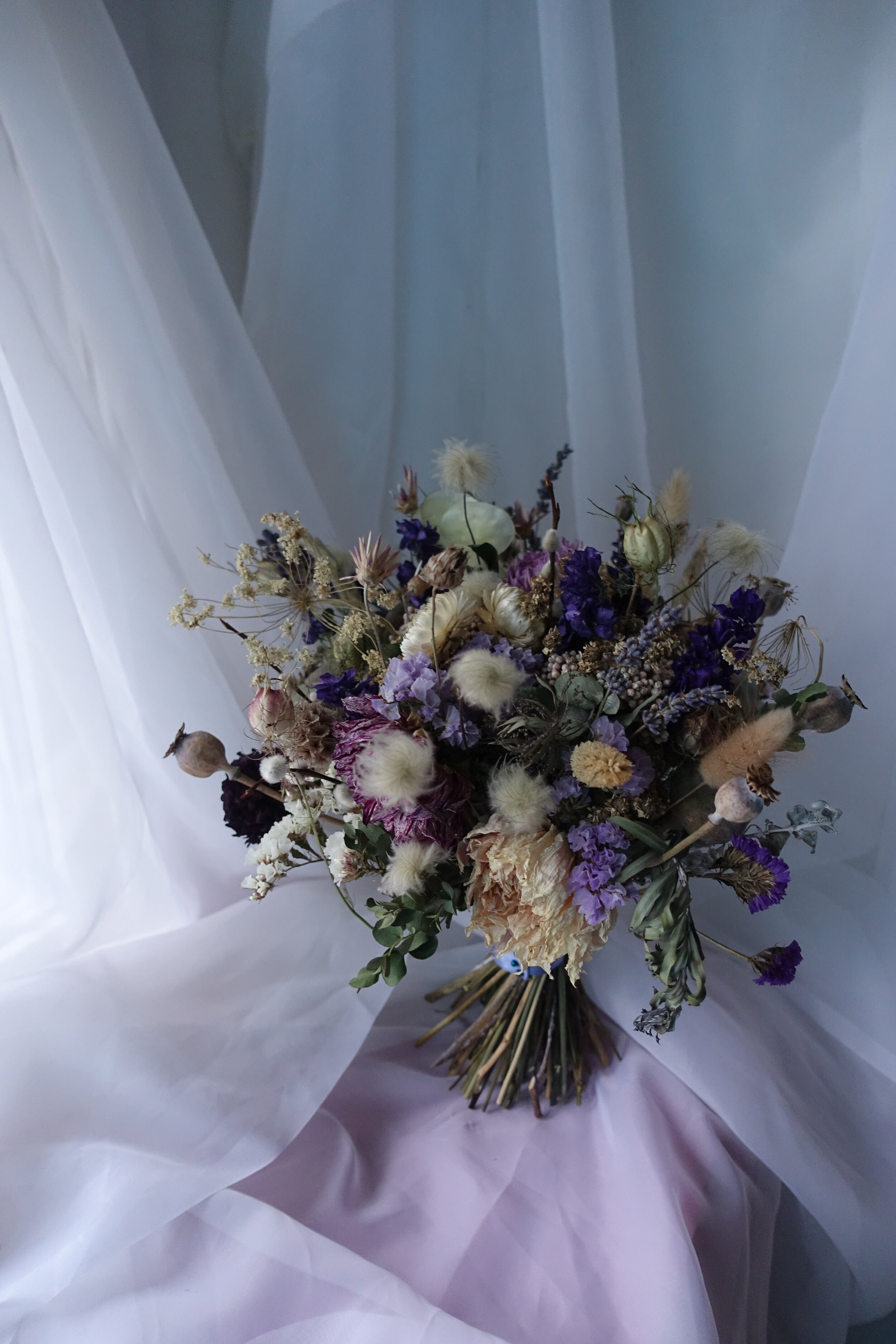Credit: Светлана Высокос (stock photo) Dyed dried flowers
Over the past few years dried flowers and foliage have come back into fashion, first with the now ubiquitous pampas grass (insert swingers joke here) and now with the rise of bleached, dyed and painted products. Dried products are great for adding texture to fresh arrangements or for full dried arrangements, which obviously last a lot longer than fresh flowers.
For years bleached, dyed and painted materials were popular for Christmas with lots of “frosted” and “glittery” additions to put in bouquets and arrangements but now we are seeing a definite trend for whiter than white foliages like bleached ruscus and bright colour pop colours in dried flowers and grasses. If this has been done cleverly most people won’t know, when done a bit more shoddily you can see the paint lines stop half way down the stem.
As a magpie for bright clashy colours, anything kitsch and new I was drawn to these materials at first and even have some fuchsia pink pampas in the studio but I started to read more about the process and it turns out it isn’t very environmentally friendly at all.
Dried wreath made with all naturally dried materials
I won’t re-write what other growers and florists have already covered in a much more articulate and scientific way about this process, there’s a great blog here if you want to go into detail or on this podcast. Amy Stewart’s Flower Confidential also gives a good insight into this process.
Essentially to give you a basic overview though, if you look at something like bleached ruscus, which is definitely having a moment in floral fashion, different cocktails of chemicals are used to bleach the foliage of its natural colour, remove the yellowing caused by the bleaching process, remove the smell of bleach and other chemicals, and finally add a strengthening agent to bolster the now fairly weakened stems. If the foliage is to be coloured then that would likely be an additional chemical treatment.
None of the packaging of these dyed, bleached or painted materials that I have seen at the wholesalers have any information on the chemicals used in the process and whether protective equipment should be used when handling it. They also don’t have any information on the packaging on how it should be stored safely so the chemicals don’t react with other products and whether it is food safe.
I also wonder whether the people carrying out the colouring process are given adequate PPE and how the chemicals are disposed of after the colouring process. If something like acrylic is used to colour them then this is essentially a single use plastic and I hope that this does not find its way into rivers and waterways.
What is frustrating is that more and more florists and non florists alike are using these dyed, painted and bleached materials because it’s fashionable and they are marketing it as sustainable or eco-friendly because it’s dried and can be used again and again. However whether they know the background on the colouring process or not, it is far from environmentally friendly and effectively means these businesses are green-washing to jump on the sustainability bandwagon. There are images of bright dried flowers all over Instagram, Etsy and glossy magazines but flowers dyed naturally do not retain the same vivid colours as their fresh versions, and that is part of their appeal.
People are selling these bouquets without warning customers of the toxic chemicals they have been treated with (and in some cases are probably still covered in) and the environmental impact of the colouring process. This means that people have started putting them directly into wedding cakes or other foods and I hate to think what happens if those chemicals are eaten.
Over the past few years as the cutting garden has developed I have experimented with drying materials that I haven’t cut for weddings and other orders. There’s a lot to learn from what point to cut a flower to make it dry well, to the natural drying process itself and how to store them. Then working with dried products brings all sorts of new challenges (and mess) as they can be very fragile and the drying process means the stems are no longer flexible so it is part of the challenge to stop the designs looking too rigid. I have really enjoyed this learning process and I’ve still got lots to learn. I’ve gone back to some of my grannie’s old flower arranging books from the 30s and 40s to get inspiration. This has all made me decide that I will not be using any dyed, bleached or painted materials and will continue to concentrate on locally grown and sourced flowers and foliage where I can me more sure of the history of the product.
If you have any questions about dried flowers or would like to see some more examples of my dried flower work get in touch, follow me on Instagram or check out my last dried flower blog post.




